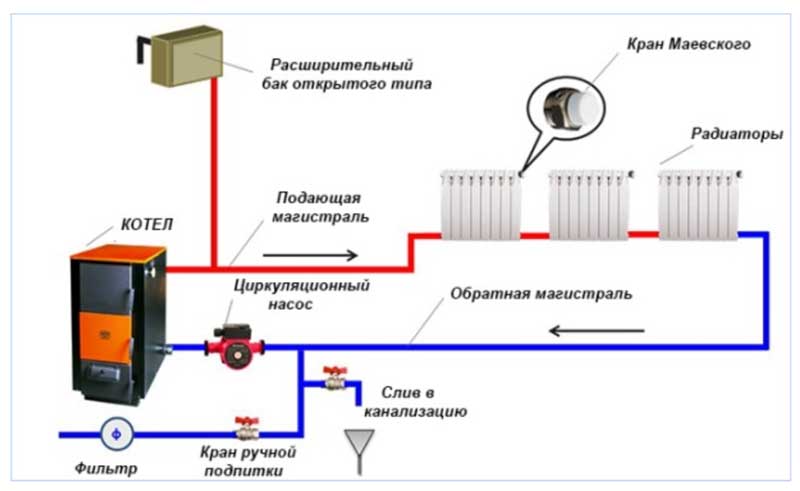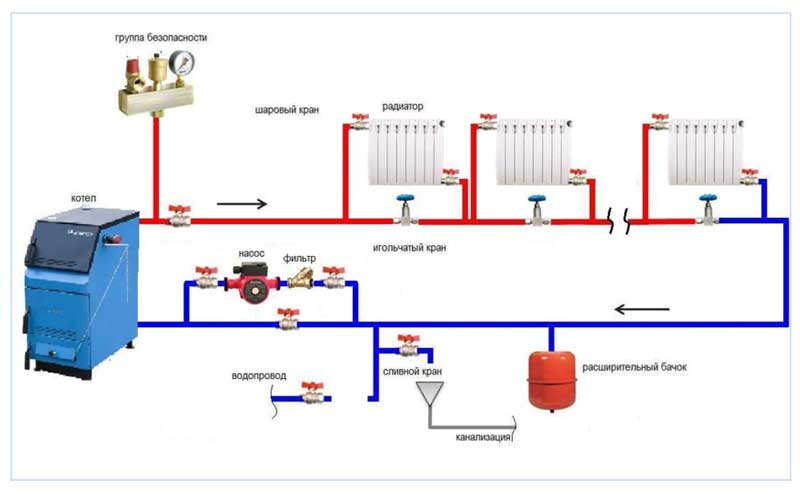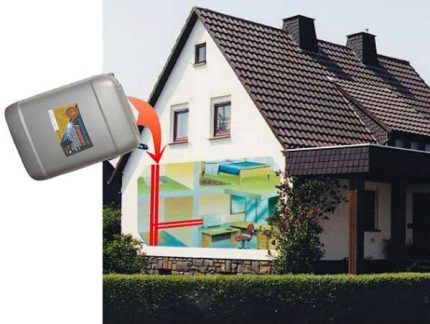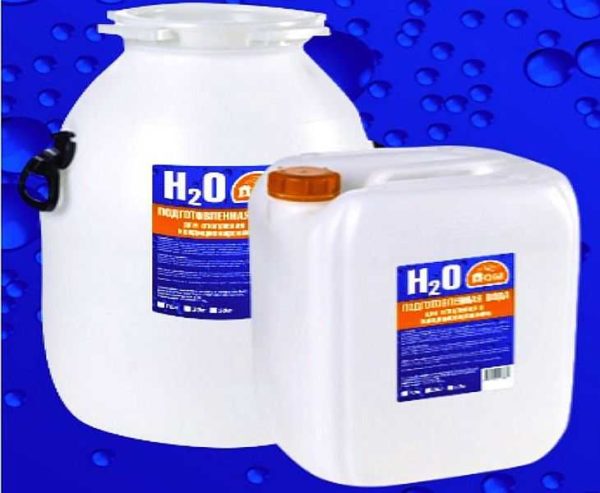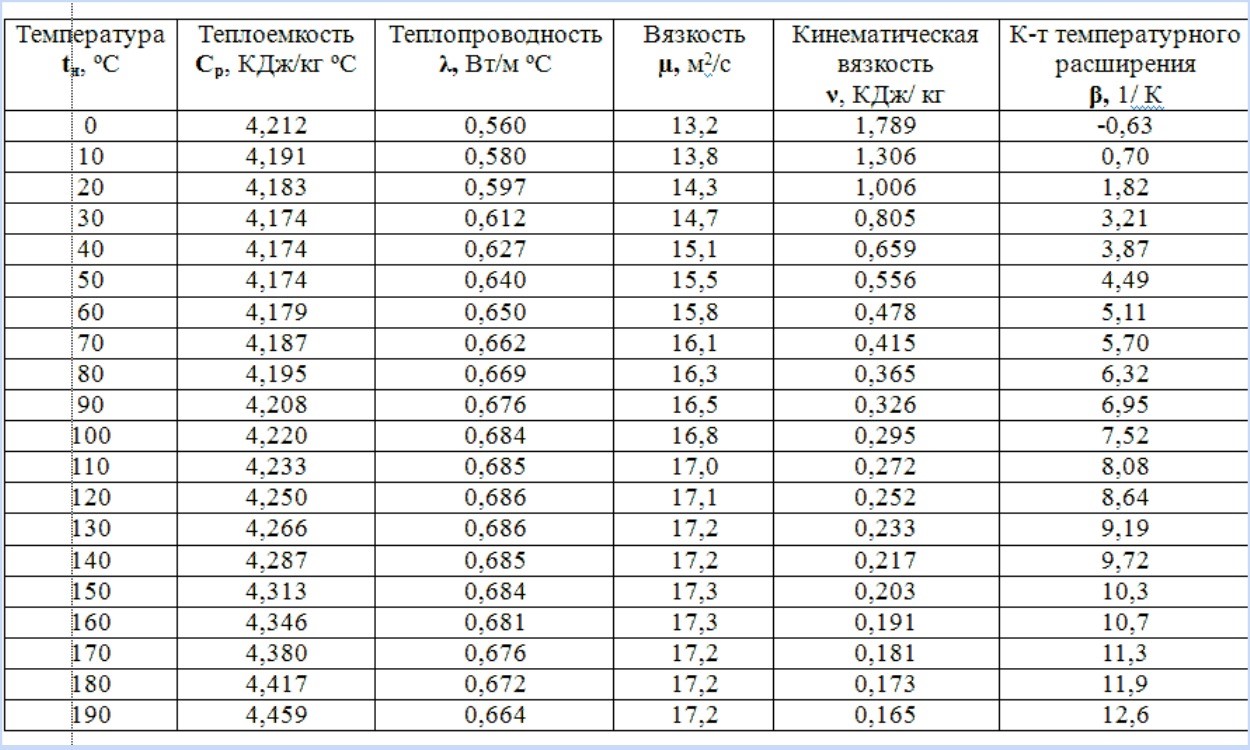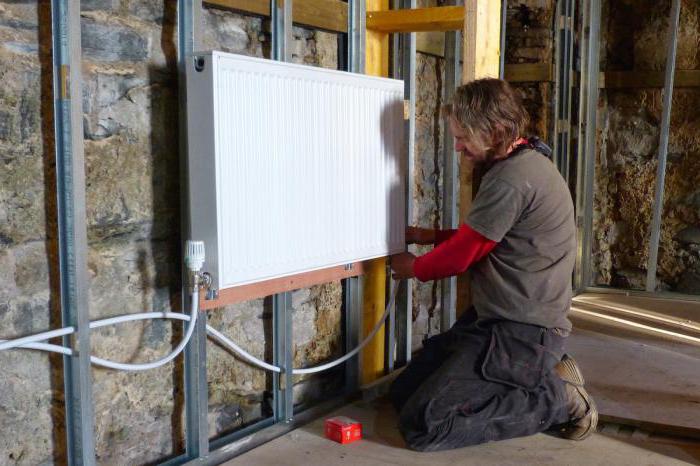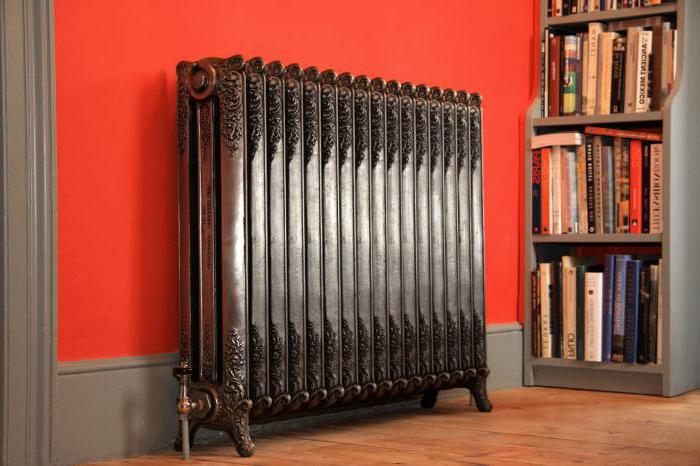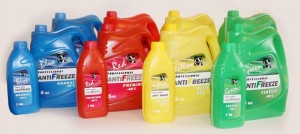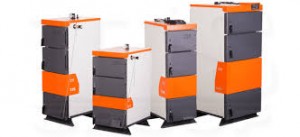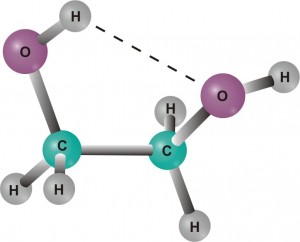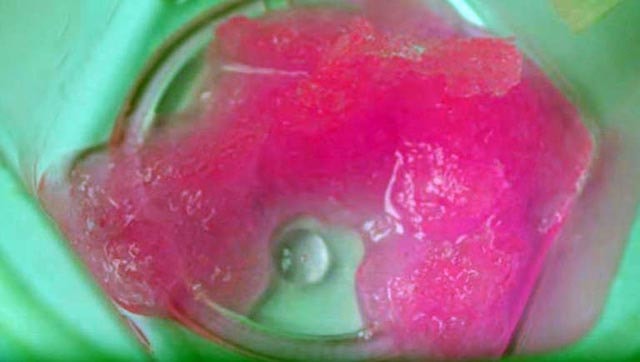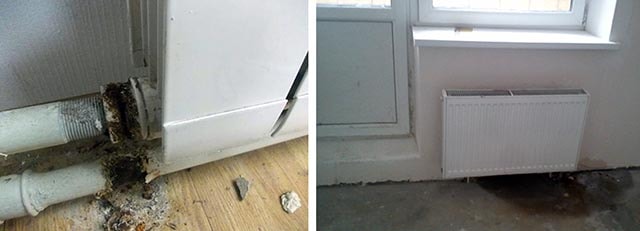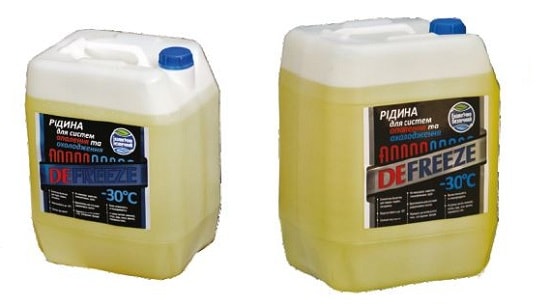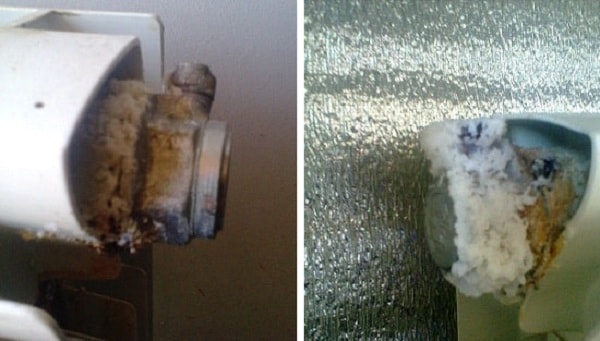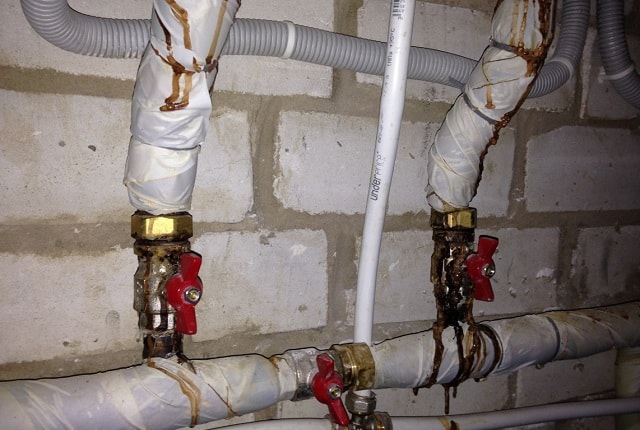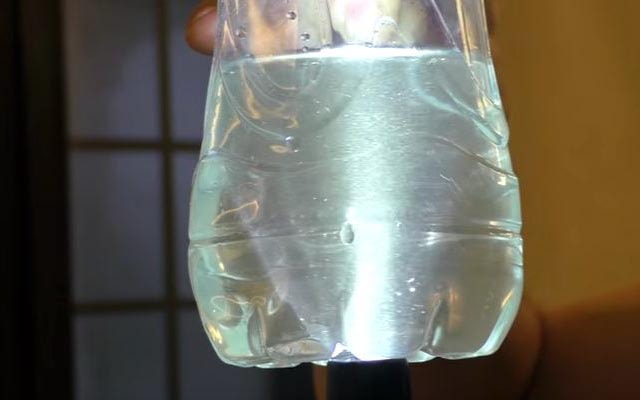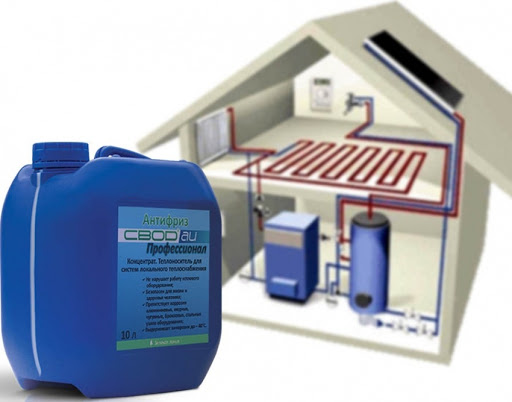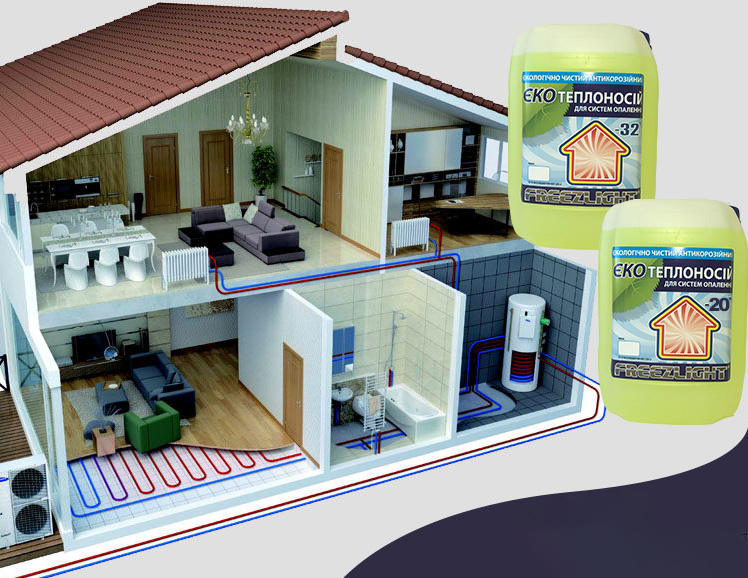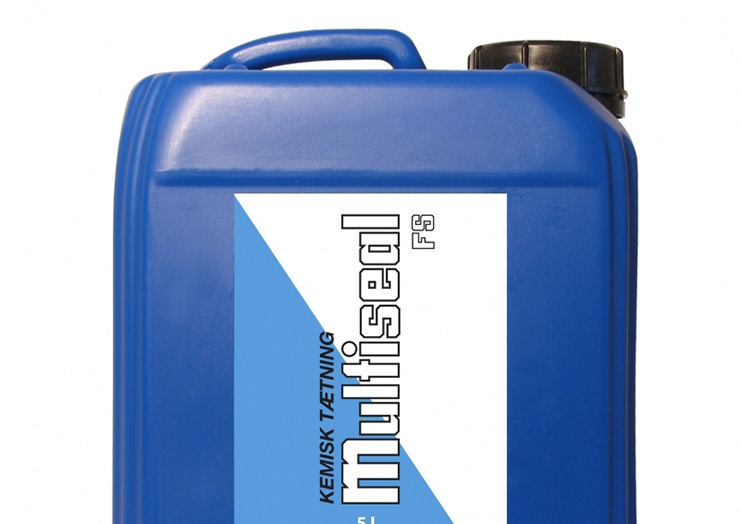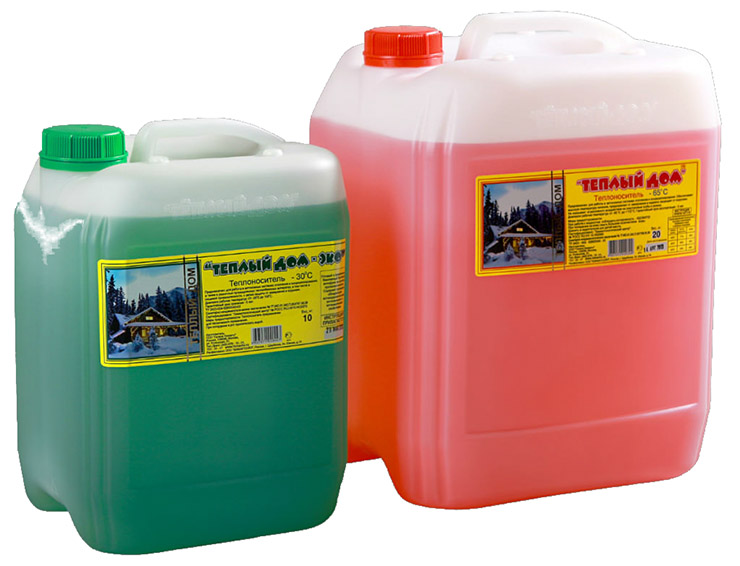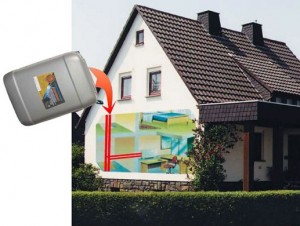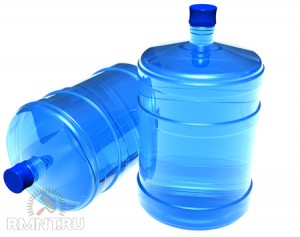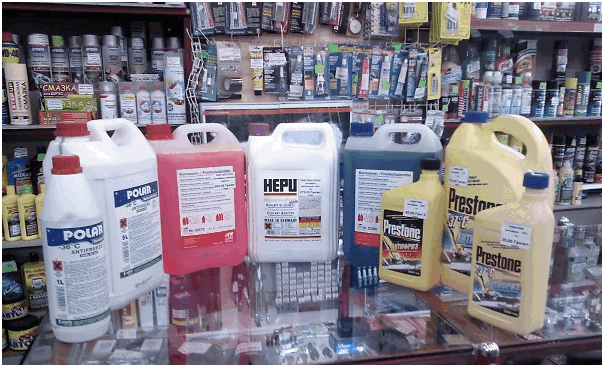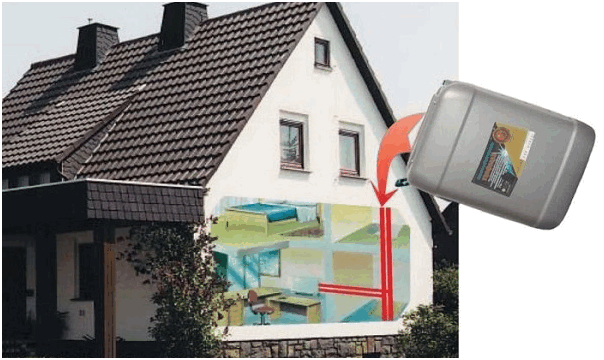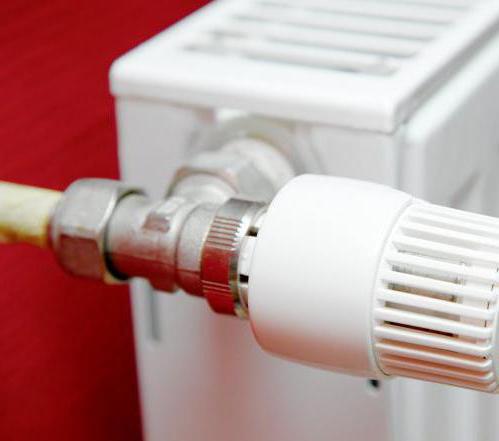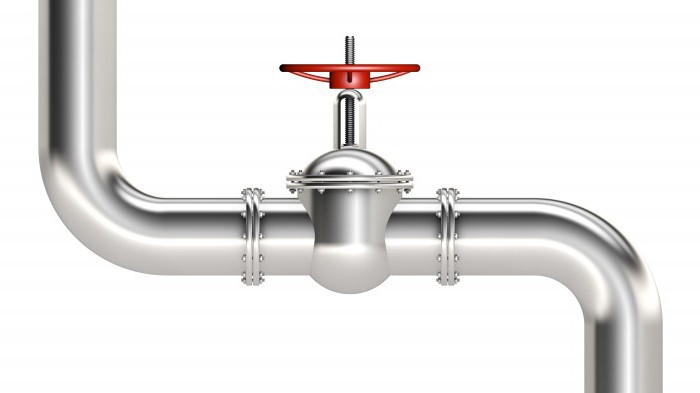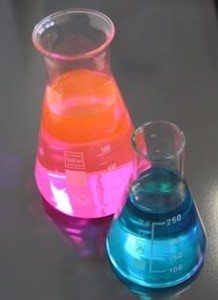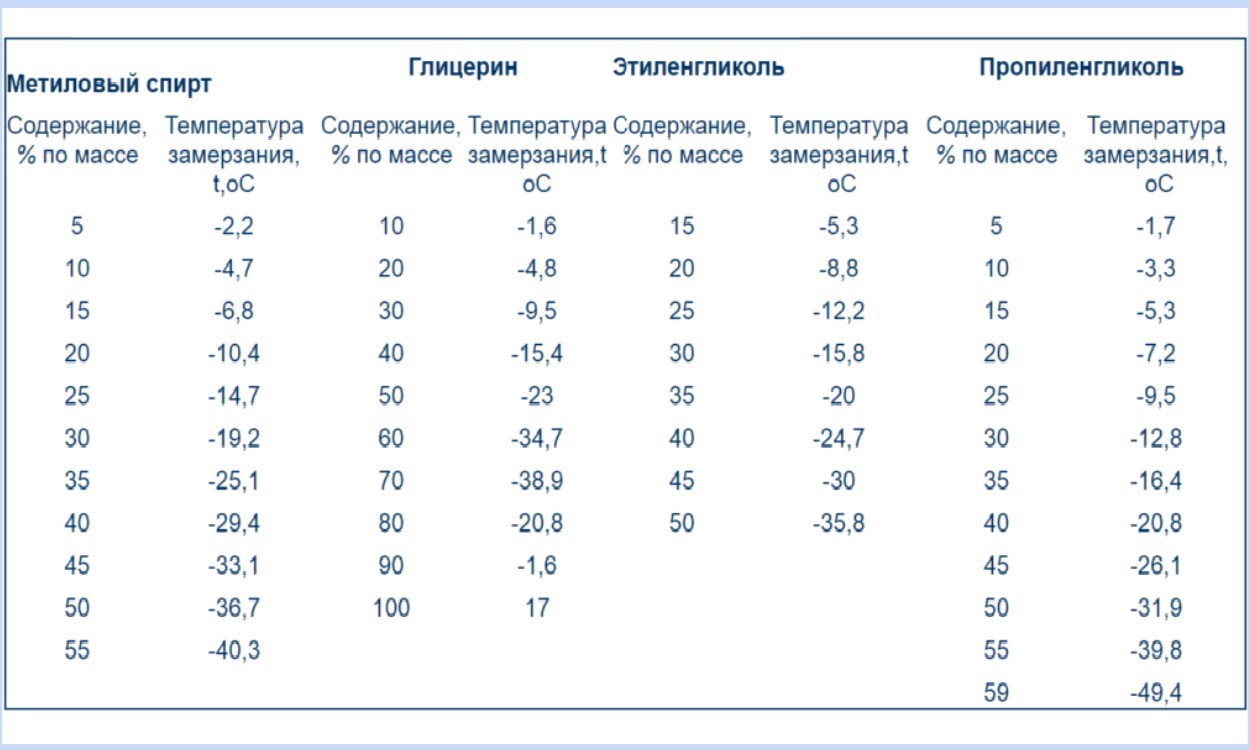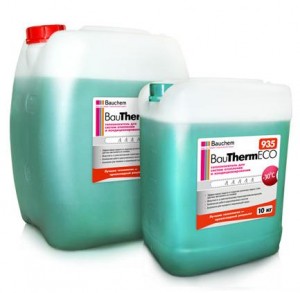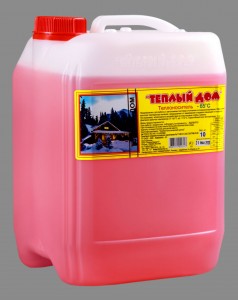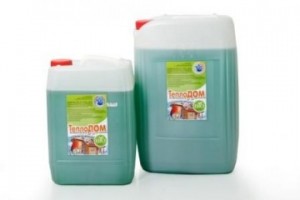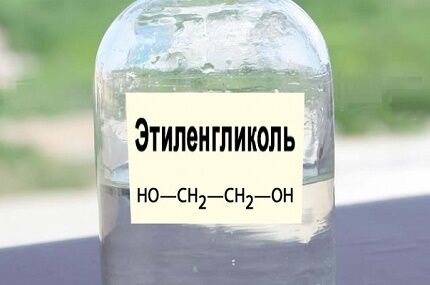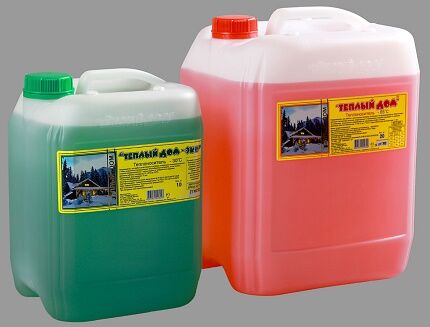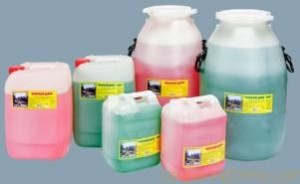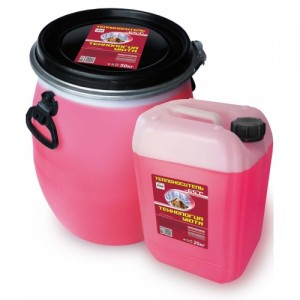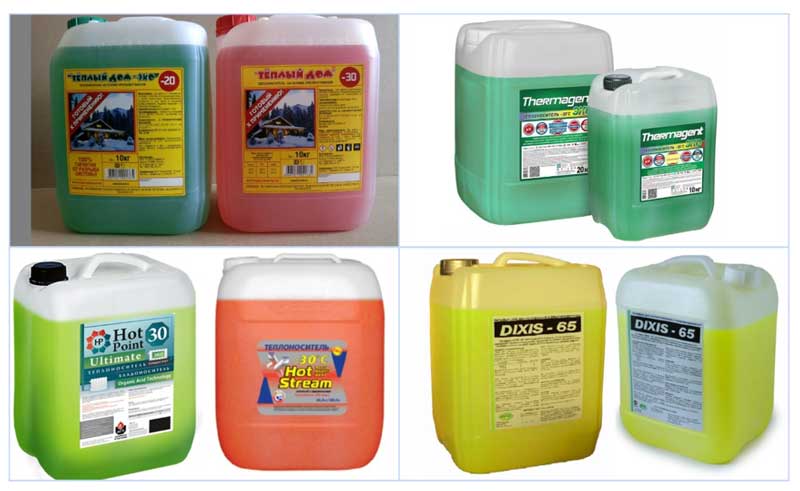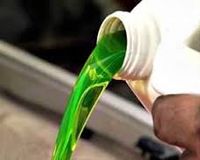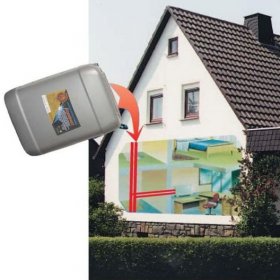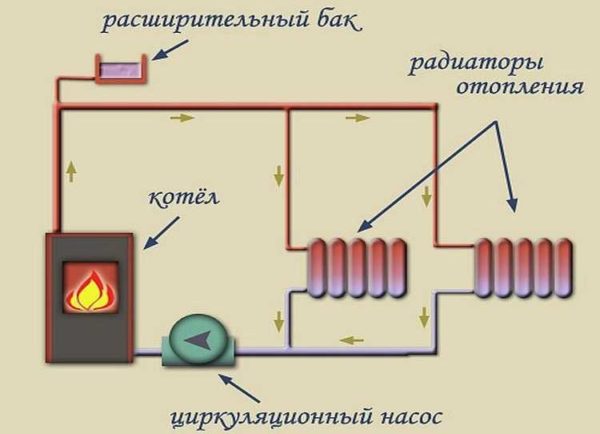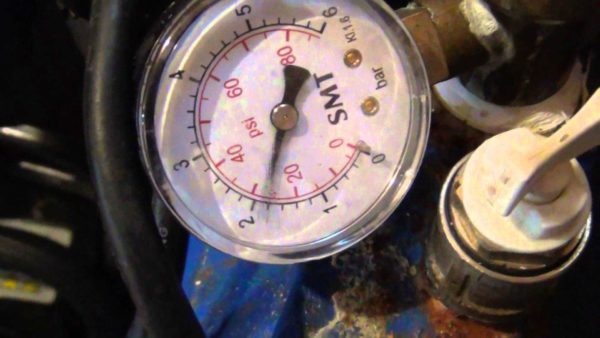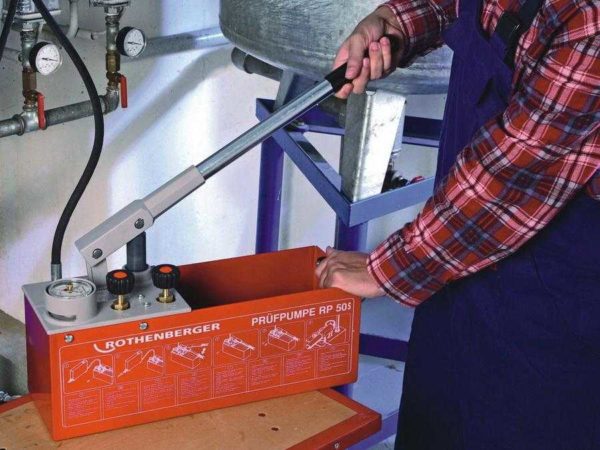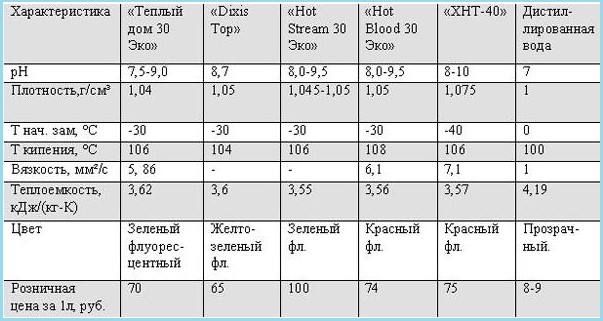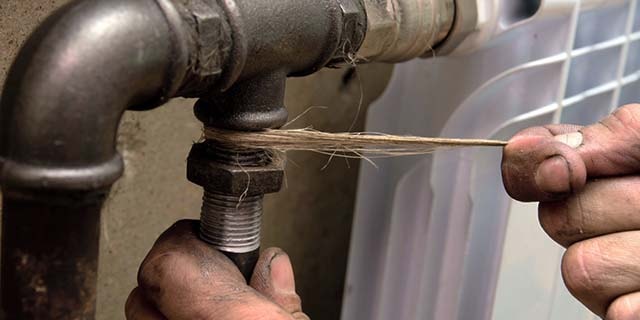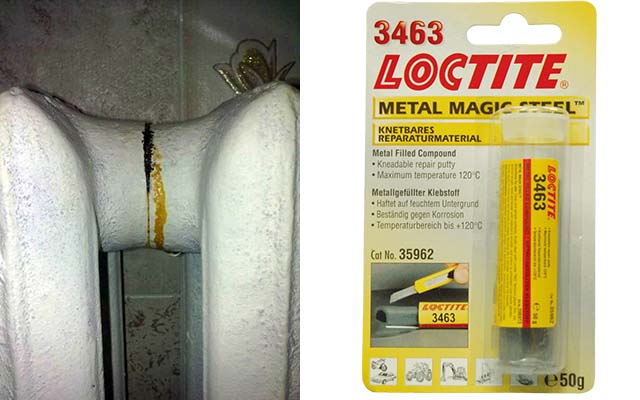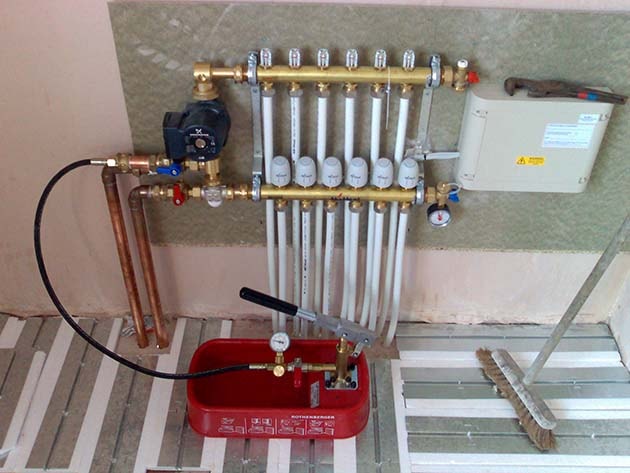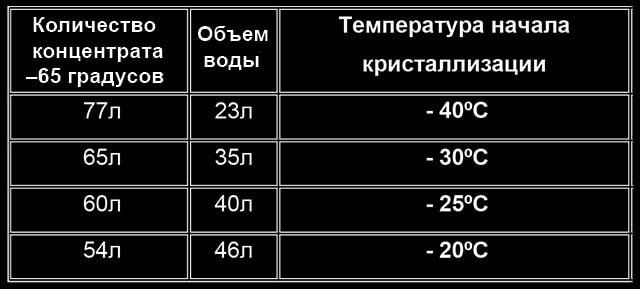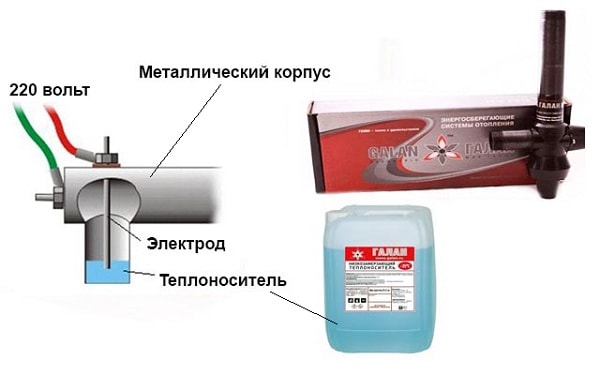Basic requirements for a coolant for heating country houses
The coolant that should be poured into the heating system of a country house must have the following properties:
- Have a high heat capacity. This indicator characterizes the property of a substance to accumulate thermal energy – the more the working fluid absorbs energy, the more it will be supplied to heating radiators.
- Viscosity. The working fluid must have a low viscosity – in this case, the electric pump will need less electricity to supply the liquid.
- Environmental friendliness. Many liquids with suitable physical parameters for use as a heat carrier are not used as a working fluid due to the high risk of harm to human health..
- Security. The heat-conducting liquid must not be explosive and fire hazardous..
One-pipe heating system circuit with open expansion vessel
Perhaps it will be interesting: One-pipe heating system – pros and cons, popular schemes
- Neutrality. The coolant should not have a harmful effect on pipes, boilers, heating equipment, radiators, leading to their corrosion, chemical damage and, accordingly, rapid failure.
- Price. The price of a heat transfer fluid is the most important parameter when choosing suitable materials, many of them with good physical characteristics are not used in systems for the reason that they are too expensive.
- Temperature. The liquid supplying heat must withstand the maximum and minimum operating temperatures, as well as their lower and upper limits, taking into account emergency situations (power outages, equipment breakdown, damage to the line).
- Lifetime. All antifreezes during operation change their chemical properties with deterioration of technical parameters. When used in automotive technology, it is recommended to change them every 3 – 5 years, this parameter must be taken into account when used as an antifreeze liquid, choosing a composition with the longest service life.
How does antifreeze differ from water?
Antifreeze for heating has a higher density than water, so when the air temperature drops, it does not freeze. That is why accidents due to burst pipes can be avoided in this way. Antifreeze should be filled in those systems in which it is possible.
What types of antifreeze are?
- Antifreeze for heating systems is a liquid based on ethylene glycol or polypropylene glycol. The ethylene glycol formulation is toxic and should not be allowed to come into contact with human or animal skin. This substance must not be overheated, otherwise it decomposes, resulting in the formation of insoluble sediment and acids, which lead to pipe corrosion and the formation of carbon deposits..
- Propylene glycol based antifreeze is safe for humans. It can be used for heating systems with a double-circuit boiler. Compared to ethylene glycol, this antifreeze for heating systems has better heat transfer, so the air in the room heats up faster, but the price is also higher.
The composition of antifreeze always contains additives that prevent the formation of corrosion, scale on the pipe walls, sediment, destruction of polymer pipes or gaskets.
Antifreeze composition
Low-freezing liquids consist of an active substance (antifreeze 60 – 65%), distilled or deionized water (about 30 – 35% of the total volume) and 3-4% of special additives (corrosion inhibitors), which are supplied by large foreign chemical concerns (BASF). Sometimes the manufacturer supplies the market with cheap low-freezing liquids, which include diethylene glycol, which has low chemical stability and, accordingly, a short service life..
How to use antifreeze correctly?
When heated, the volume of liquid in the circuit increases, and the speed of movement decreases, which is why an additional container and a pump will be required, which will help the movement.
Before adding antifreeze, flush the circuit with a special agent and water. Only then can you fill in an anti-freeze liquid..
Determine how much antifreeze is needed and must be filled by a professional. Otherwise, there may be problems with heating, leaks. Antifreeze in the heating system is replaced after 5 or 10 years.
When to use antifreeze?
Before you start looking at alternative fluids, don’t discount the water. If heating is installed in a house where residents live permanently, then water will be one of the safest and most reliable options..
She, as a heat carrier, has optimal parameters for circulation through the circuits of heating systems.
However, at the peak of winter frosts, the slightest crystallization of water can cause a serious accident with the destruction of the pipeline and heating equipment units..
If we are talking about a country house, which is periodically run over, or when on weekends the family often leaves their abode, leaving the heating unattended, then the coolant used must be resistant to the range of low temperatures characteristic of the region.
Only for the use of chemical compounds as a carrier of thermal energy, it is necessary to prepare the heating circuits. The system must be completely sealed because the liquid is toxic and flammable to varying degrees.
Do not use “pure” antifreeze in heating circuits. Since undiluted anti-freeze compounds are aggressive and tend to stimulate the development of corrosion, they are diluted with water
The owner must take into account that the non-freezing liquid must be changed periodically, which is fraught with additional costs.
Some models of boiler equipment have specific recommendations for the use of a certain brand of heat carrier. If you use a liquid of a different composition, you can lose the boiler warranty..
Features of using water as a heat carrier
From the point of view of the efficiency of heat transfer, water is an ideal heat carrier. It has a very high heat capacity and fluidity, which allows it to deliver heat to the radiators in the required volume. What kind of water to fill? If the system is of a closed type, you can fill in water directly from the tap.
Yes, tap water is imperfect in composition, it contains salts, a certain amount of mechanical impurities. And yes, they will settle on the elements of the heating system. But this will happen once: in a closed system, the coolant circulates for years, replenishment with a small amount is required very rarely. Therefore, a certain amount of sediment will not bring any tangible harm.
Water as a heat carrier for heating systems is almost ideal
If the heating is of an open type, the requirements for water quality, as for a heat carrier, are much higher. Here there is a gradual evaporation of water, which is periodically replenished – the water is topped up. Thus, it turns out that the concentration of salts in the liquid is increasing all the time. And this means that the sediment on the elements also accumulates. That is why purified or distilled water is poured into open-type heating systems (with an open expansion tank in the attic).
In this case, it is better to use distillate, but getting it in the required volume can be problematic and expensive. Then you can fill in purified water, which is passed through the filters. The most critical is the presence of a large amount of iron and hardness salts. Mechanical impurities are also useless, but the easiest way to deal with them is – several mesh filters with a cell of different sizes will help to catch most of them.
In order not to buy purified water or distillate, you can prepare it yourself. First, pour and stand so that most of the iron settles. Gently pour the settled water into a large container and boil (do not close the lid). This removes the hardness salts (potassium and magnesium). In principle, such water is already well prepared and can be poured into the system. And then top up with either distilled water or purified drinking water. This is not as expensive as the original fill..
Pros and cons of water as a coolant
Water is the most commonly used heat transfer fluid and has the following properties:
- Availability. Water is everywhere, it costs almost nothing, in emergency situations it can always be drained and refilled..
- High specific heat capacity. Among all liquids, water has the highest heat capacity with an average value of 4200 J / kg * K. (4.2 KJ / kg * K) – this means that it heats up slowly and cools slowly.
- Low viscosity. Water has a low kinetic viscosity of 1.006 m2 / s (10-6) at a temperature of 20 ° C, with increasing viscosity it drops and at a boiler operating temperature of about 70 C. this indicator has a value of about 0.4 m2 / s . (10-6). This means that the water is less susceptible to resistance when moving while it is being pushed into the system by the impeller of the electric pump..
- Low coefficient of volumetric expansion. When heated, water slightly increases in volume, compared to zero temperature at 80 degrees, its volume increases by 2.8%.
- Environmental friendliness. The use of water is harmless to health, in case of emergency leaks, it will not harm human health.
- Neutrality. Water is chemically neutral with respect to all synthetic materials, it does not have a harmful effect on the currently widely used pipelines made of cross-linked polyethylene (metal-plastic) used for heating systems.
The disadvantages include the following properties of water:
- High freezing point. This is the main drawback that does not allow to operate the heating system of the house in the winter when it is turned off..
- Corrosive to steel. The use of water does not allow the use of cheap steel as a material for pipelines for a long time, it is necessary to operate pipes made of more expensive materials and sanitary fittings made of non-ferrous or stainless alloys.
- Scale. When the temperature rises, the salts contained in the water settle on pipes, in radiators and plumbing fixtures – this leads to a decrease in the section of the working channel and disruption of the operation of shut-off and control valves
For reference
If you are faced with the problem of how to fill the heating system in a private house, you should take into account that water in its usual form should not be used, because it is rich in salts and oxygen. Over time, from such additives, scale will settle on the internal surfaces of the heating system and corrosion will appear. And in order for the system to work without interruption, the liquid must be softened before use..
To do this, you can use one of the existing methods. It can be thermal or chemical technology. In the first case, the technique is based on boiling. The water must be placed in a metal tank, in which it must be heated. Boiling will remove carbon dioxide, and salt will be deposited at the bottom of the vessel. Stable compounds of magnesium and calcium will still remain in the water. The chemical method works with reagents. With the help of soda ash, sodium orthophosphate and hydrated lime, the salts become insoluble and fall out, becoming a precipitate. Subsequent filtration will eliminate residues of harmful substances.
Why do many people refuse water
If you are faced with the question of what to pour into the heating system of a private house for the winter, then most likely you will have to give up water. In this case, such a parameter of the coolant as the temperature regime plays an important role. If the temperature in the building drops below 0 ° C, then the liquid will freeze, and this will cause a breakdown of the heating system.
How to choose the right fluid?
Today, there are hundreds of product options on the market for heating appliances and consumables for them. It is rather difficult to choose high-quality and safe antifreeze among them, because each brand uses all kinds of marketing tricks to attract the attention of the buyer to their product. In order not to fall for the fishing rods placed by advertisers, the homeowner needs to understand what requirements the liquid for heating boilers, poured into the circuit, must meet.
Before buying a liquid for heating, the owner needs to find out some of the technical characteristics of the boilers, as well as familiarize himself with the list of antifreezes that are compatible with radiators and pipelines connected to the circuit. In addition, it is necessary to clarify the operating parameters of the heating system and the features of operation..
Next, you should study the specific requirements of specialists for antifreeze that can make the heating system productive, stable and safe..
Pay attention to the following parameters:
- Operating temperature range;
- heat capacity;
- inert chemical composition;
- the presence of anti-corrosion properties;
- no sediment in the liquid when heated;
- stability of chemical properties – density, viscosity, heat capacity;
- no toxic emissions during use.
Functional heating boilers liquid fuel, gas and solid fuel will last much longer if they are filled with antifreeze with a maximum operating temperature range, stable chemical composition and acceptable performance, guaranteeing the protection of heating devices from corrosion, scale and solid sediment. You can buy such a liquid only from a trusted manufacturer. But the use of the wrong antifreeze can lead to a number of undesirable effects..
Negative effects that may appear:
- the formation of foam inside the circuit during heating
coolant;
- precipitation, which provokes overgrowing of pipes and clogging of the boiler heat exchanger;
- corrosion formation;
- the appearance of leaks;
- violation of the boiler tightness;
- release of toxic substances.
Advantages and disadvantages
The special fluid has a number of features. It has both pros and cons. Antifreeze benefits:
- the composition retains its characteristics and properties, even if it is constantly in the heating system;
- does not freeze at subzero temperatures;
- no scale builds up in equipment and pipes;
- does not affect the condition of seals and gaskets: they will not dissolve, dry out or swell.
But when pouring non-freezing liquid into the heating system, there are also disadvantages:
- it has less heat transfer properties;
- acts aggressively towards metal;
- in the event of a leak, harmful substances will be released.
In addition, antifreeze is viscous, respectively, when choosing equipment for a heating system, its characteristics must be taken into account..
In this video, you will learn the benefits of non-freezing:
Antifreeze classification
There are many types of this product on the market. Non-freezing liquid for heating boilers can be made on the basis of an aqueous solution of glycerin, ethylene glycol, propylene glycol, and so on. Since all substances are highly corrosive, special additives are present in the composition of liquids..
Each species has certain specific characteristics:
- ethylene glycol-based liquid – common among buyers, since it has the most affordable cost. But it is the most toxic and cannot be used for double-circuit boilers. May be hazardous to health if released into the water supply system. If the boiling point rises above 110 degrees, the substance can form a precipitate that can interrupt the operation of a number of elements of the system;
- from propylene glycol – the properties of the composition are almost similar to the previous one, but it is less harmful and safer;
- based on glycerin – an environmentally friendly antifreeze, non-toxic, protects the system from corrosion. When going into a solid state, it does not increase the volume, but in order for the system to start, you just need to warm it up;
- from a natural solution of bischofite – has a high level of heat transfer and heat capacity, the freezing point is low, and the boiling point is high;
- salt carriers – made on the basis of solutions of sodium, calcium and other mineral salts. Highly corrosive to pipes.
The products can be sold both in finished form and in the form of a concentrate for solution preparation. Different types of antifreeze have their own freezing point. Experts believe that it is best to use formulations, the freezing point of which is 20-25 degrees below zero..
About the pros and cons of glycol antifreezes
The main advantage of glycol-based artificial heat carriers is the preservation of the liquid phase at negative temperatures. We list other positive points from the use of antifreeze in closed water heating systems:
- heat carriers do not contain calcium and magnesium salts that form scale inside heat exchangers;
- due to the penetrating ability of glycols, the effect of lubrication of moving parts occurs, ball valves and thermostatic valves do not sour, fittings last longer;
- the boiling point of the antifreeze 103-106 ° C postpones the moment of vaporization and airing in case of overheating of the solid fuel boiler;
- when the temperature drops below the freezing threshold, the glycol solutions turn into a gel mass.
Note. The clause about scale means that the “non-freeze” is diluted with demineralized distilled water.
When freezing, glycol mixtures form a slurry that is not able to break pipes and heat exchangers
Let’s explain the last 2 points. Ordinary water, often poured into the heating system of country houses, begins to boil at 96-98 ° C, actively releasing steam. If the circulation pump is on the supply of the TT boiler, the vapor phase enters the chamber with the impeller, the pumping of water stops, the boiler overheats completely. A higher boiling point of antifreeze will allow to postpone the moment of an accident.
Unlike water, glycol hardened in frost does not expand and does not destroy pipe walls. In the event of freezing, the only unit will suffer – the forced circulation pump. Crystallizing gel will jam the impeller and the motor will burn out.
Unfortunately, there are plenty of disadvantages for non-freezing substances:
- Ethylene glycol is poisonous – requires careful handling and disposal of the solution. Glycerin and polypropylene glycol are harmless.
- The heat capacity of “non-freezing” is 15% less. To deliver the required amount of heat to the batteries, the fluid consumption will have to be increased.
- The viscosity of the antifreeze creates additional hydraulic resistance. A more powerful and expensive circulation pump will be needed.
- Good fluidity is a double-edged sword. Glycols penetrate the slightest leaks, from where plain water will not flow.
- Heat carriers and additives decompose during operation, losing their frost-resistant properties and falling out in flakes of sediment. The maximum service life of 1 filling is 5 years, then the heating is flushed and replaced.
- When using antifreeze, many manufacturers of gas boilers deprive the purchased product of the warranty..
Glycolic liquids are poorly compatible with electric boilers. Instructions for the use of various antifreezes categorically do not recommend filling systems that work in conjunction with electrolysis heaters with antifreeze. That is, for electrode boilers of the “Galan” type, a special coolant is needed, developed by the specified company..
Under rare circumstances, antifreeze is capable of emitting flammable gas that breaks through the automatic air vent. Example: the heat source is an electric boiler, the heaters are Chinese-made aluminum radiators. Heating the glycol causes a complex chemical reaction and gas formation. The fact is demonstrated in the video:
New mineral heat transfer fluids
We decided to highlight the description of these liquids, since they are made on the basis of a natural mineral – bischofite. The substance is a magnesium salt of hydrochloric acid, the full name is magnesium chloride hexahydrate. The manufacturer claims the following characteristics of the finished antifreeze, designed for a minimum temperature of minus 30 degrees:
- the color of the aqueous solution is light yellow, the density is 1117… 1250 kg / m³;
- boiling point – 116 ° С, freezing point – minus 30 ° С;
- specific heat capacity – 0.77 kcal / kg • ° С (3.23 kJ / kg • ° С);
- due to additives, there is no foaming and no aggressive effect on a variety of seals – silicone, paronite, EPDM and BMS rubber;
- the substance is not toxic;
- in terms of viscosity and fluidity, the drug is very close to glycolic chemicals.
Reference. The product appeared on the market after 2010. The price of the liquid as of 2018 is about $ 1. e. per liter of finished heat carrier (-30 ° С).
Compared to traditional glycol counterparts, Mineral Antifreeze benefits from higher boiling points, cost and health benefits. Negative point – increased density and low heat capacity, 23% worse than water.
The practical use of the coolant revealed a number of shortcomings, as evidenced by the reviews of the homeowners:
- The fluidity of the solution is extremely high. There were cases when antifreeze penetrated through the soldered joint of polypropylene pipes.
- On contact with air, the liquid fraction quickly evaporates, leaving a noticeable salt build-up. Similar phenomena are observed in heat exchangers and pipelines where air bubbles have penetrated..
- The substance reacts with bare metal at the weld seams. Inside the system, stalactites of iron and salt are formed, which reduce the flow area and clog the sludges.
- In case of overheating, antifreeze turns into a slurry of an incomprehensible color, which is demonstrated in the photo.
Taking into account the experience of users, we will not dare to recommend mineral antifreezes for use in heating systems of private houses. Perhaps, over time, manufacturers will eliminate the above problems and the magnesium chloride solution will be able to compete on equal terms with glycols..
Choosing “non-freezing” for heating
Advice number one: buy and fill in antifreeze only in extreme cases – for periodic heating of remote country houses, garages or buildings under construction. Try to use water – plain and distilled, this is the least troublesome option.
When choosing a frost-resistant heat carrier, observe the following recommendations:
- If your budget is limited, take ethylene glycol of any well-known brand – Teply Dom, Dixis, Spektrogen Teplo OZh, Bautherm, Termo Tactic or Thermagent. The cost of the concentrate -65 ° C from Dixis is only 1.3 USD. e. (90 rubles) for 1 kg.
- If there is a danger of antifreeze getting into the household water (for example, through an indirect heating boiler, a double-circuit boiler), or you are very worried about the environment and safety, buy harmless propylene glycol. But keep in mind: the price of the chemical is higher, the ready-made Dixis solution (minus 30 degrees) will cost 100 rubles (1.45 cu) per kilogram.
- For large heating systems, we recommend using the XNT premium coolant. The liquid is made on the basis of propylene glycol, but at the same time it has an increased service life – 15 years.
- Do not buy glycerin solutions at all. Reasons: sedimentation in the system, too high viscosity, tendency to form foam, a large number of low-quality products welded from technical glycerin.
In the light of the lantern, the smallest white flakes are noticeable – a precipitate of technical glycerin
- For electrode boilers, a special liquid is needed, for example, XNT-35. Always consult with the manufacturer before use..
- Do not confuse automotive antifreeze with heating chemicals. Yes, both formulations are made on the basis of glycol, but the additive packages are completely different. The engine coolant is incompatible with the water heating of a residential building.
- For open and gravity heating systems, it is better to use water, in extreme cases – propylene glycol diluted by minus 20 ° C.
- If the heating wiring is made with galvanized pipes, it is pointless to purchase glycol mixtures. The substance will deal with zinc, lose the package of additives and quickly degrade.
Clarification. It is unprofitable to use a frost-resistant liquid for an open heating system. Hot antifreeze will evaporate into the atmosphere through the expansion tank, the anti-freeze will have to be constantly refilled and money spent. It is unacceptable to pump ethylene glycol, as its vapors are toxic.
There is a lot of controversy on the topic of the harmfulness of ethylene glycol formulations, including on the pages of construction forums. Without denying the harmful effects of the chemical on human health, let us draw attention to a convincing fact.
Homeowners whose closed systems are well installed have been using inexpensive glycol for years without the slightest problem. Let’s hear the expert’s opinion on the video:
Criterias of choice
A factor common to all heat carriers that influences the choice of products is its environmental safety. Human health and comfort in the home depend on the quality and type of the coolant poured into the heating system.
First of all, the choice of fluid depends on the design of the heating system. It is important what material it is made of. The factors important for the choice of the heat carrier are the power of the pumps and radiators involved in the heating system, as well as the appearance of the heating boiler..
When buying a liquid for the first time, it is better to seek professional advice. This will allow you to get professional advice and avoid failure of the heating system of a country house. According to experts, it is better to use liquids with a freezing point of -20-25 ° C in heating systems of country houses..
When water freezes, its volume increases significantly, which, in the event of an emergency in the cold season, can lead to rupture of pipes and radiators. The use of antifreeze completely eliminates this possibility. It is important that its composition is of high quality and reliable..
Each heating system has its own performance characteristics. Some of them must be taken into account when choosing the type of coolant. Among them are the minimum ambient temperature and the maximum temperature of the coolant during heating. Both of these indicators are borderline when the liquid passes into another physical state..
Many manufacturers produce heating boilers in which the use of anti-freezing liquids is strictly prohibited..
After determining the performance characteristics of the coolant, be sure to pay attention to its manufacturer and cost. For living quarters, it is extremely important to fill the heating system with an environmentally friendly liquid. Coolants with expired service life can become fatal to humans..
An important criterion for choosing a fluid is its chemical composition and the type of additives added to it. The latter pay direct attention to the possible period of use of the coolant in the system. You can work for the longest time on organic antifreezes..
Selection recommendations
Water, unlike any antifreeze, is an environmentally friendly liquid. However, it can cause scale and corrosion. However, if the family lives in the house permanently, water is a more acceptable option for heating..
But it is better to use special fluids when, in the cold season, the heating is turned on from time to time. The fact is that if the heating was not started at the onset of cold, there is a risk of pipe breakage due to an increase in the volume of water during the transition to a solid state. With antifreeze, this problem is excluded..
When choosing antifreeze, you need to rely on the heating system itself
The elements for the heating system themselves must be chosen taking into account what exactly will be used – water or antifreeze, then the risks will be much less. But if the heating system has been working for a long time and it was decided to change the water to an anti-freeze, then when choosing one or another of its types, it is recommended to consider the following:
- a certain type of anti-freeze for heating a private house should be selected, focusing on the very design of the heating system. It is important here what metal its parts are made of, what power the pumps and radiators have, and what type of boiler is used;
- the composition must be reliable and of high quality;
- navigate the properties of the additives that are contained in antifreeze in order to know how it can affect the material of the equipment;
- it is necessary to dilute the non-freezing liquid strictly according to the instructions;
- when using, do not forget about the service life of antifreeze (in most cases it can be used no longer than 5 years).
If the liquid is purchased for the first time, you can contact a specialist in the store who will advise the most suitable option for each individual case. The right choice is a guarantee that the heating system will work fully.
Volume calculation and filling
In order to avoid accidents, it is necessary to pour liquid into the heating system in a strictly defined volume. It is calculated taking into account the following factors:
- type of heating system;
- her material;
- internal volume of the boiler;
- area of the room to be heated.
It is recommended to carry out the calculation according to the instructions for the equipment, and also take into account whether antifreeze can be used in it at all. But there are situations when there is no information on this in the technical documentation, then the calculation is carried out by studying the relevant literature. And in some cases, you will need the help of a specialist who will help you carry out all the calculations and get the system into operation..
After pouring, do not forget to test the equipment
You also need to know how to properly fill the coolant into the system. If it already contains old media, then it will need to be drained. It is also necessary to check the degree of contamination, perhaps the system will need to be cleaned first, otherwise the mixing of the two anti-freezers will cause an unexpected chemical reaction..
In a closed system, the filling point must be below other heaters. Antifreeze is poured through pumping equipment, but it is necessary that the pressure in the pipes be no higher than 3 atmospheres. And if it is open, then the filling must be done through the expansion upper tank.
After that, the operation of the equipment is tested. The temperature in the system rises, during which the tightness of the units is checked and the absence of unnecessary noise during the circulation of the coolant.
During the period of use of the system, antifreeze will need to be refilled periodically, so it is better to purchase it with a certain margin..
Limitations and caveats
As mentioned, you should choose the right anti-freeze for the heating system of a private house, depending on its type. In addition, it must be borne in mind that it is not suitable for all boilers. If the recommendations are disregarded, the equipment may fail due to damage to the pipes..
It is not recommended to use antifreeze if the equipment has a galvanized surface. In this case, the protective layer quickly collapses, and the element will fail over time. Since it has a high viscosity, the heating system must be additionally equipped with circulation pumps. Moreover, their performance depends on the critical level of the freezing temperature: the lower it is, the higher the performance should be..
Antifreeze must be changed strictly according to the manufacturer’s instructions. Over time, it loses its properties, which negatively affects the operation of the entire system. It is not recommended to use automotive antifreezes, as they are made predominantly from unsafe substances..
If the antifreeze is in the form of a concentrate, it should only be diluted in distilled water. Running water contains many foreign substances that, when combined, can cause a dangerous chemical reaction.
Can I do it myself
Antifreeze is a solution in which water accounts for up to 70% of the total volume, the rest is additives that reduce the crystallization threshold to minimum values. These include the main component (glycerin, ethylene glycol and others) and additives that prevent the formation of foam and crystalline precipitate with increasing temperature.
And if you can choose the main component yourself, then choosing the right additive is difficult, since their full composition has not been fully studied and the manufacturers do not disclose it. For this reason, it will not work correctly to make the composition at home..
If you neglect this recommendation and make an anti-freeze for heating the house yourself, then the following consequences are possible:
- when the coolant heats up, the level of foam increases, which leads to the rapid formation of sediment on the walls of radiators and pipes;
- due to a decrease in the heat transfer of a homemade anti-freeze, the heating efficiency will significantly decrease;
- homemade heating fluid can have a bad effect on steel due to the large amount of oxygen and corrosion will accelerate.
To prevent this from happening, it is strictly forbidden to use low-quality or homemade antifreeze. The liquid should be selected only from factory production and a reliable manufacturer..
Before pouring antifreeze into the heating system, you need to carefully re-read the instructions for it, perhaps the use of this heating element is prohibited. The very same liquid must be selected correctly and comply with all requirements for use..
What are the criteria for selecting the type of coolant?
The question of how to pour liquid into the heating system and which antifreeze to give preference begins to bother property owners long before the first start of the boiler. The fact is that antifreeze is selected for specific models of heating equipment used in the house. The owner also builds on other parameters – the type of housing, the characteristics of the heating system in it, their financial capabilities, etc..
The main guarantee of a properly selected antifreeze is well-placed priorities. For example, if the house is designed for year-round living, and the owners do not plan to leave it during the winter and suspend the operation of the heating circuit, then ordinary water can be used in the system instead of antifreeze. In other cases, when the priority is placed on the reliability and stability of the heating circuit, the owner must choose an all-season antifreeze, which will save expensive heating equipment from accidents and protect the house from freezing. It is also important to take into account the criteria for the cost of antifreeze, its toxicity, flammability, etc..
Non-freezing liquids as a heat carrier
The use of antifreeze in heating devices is more relevant for the harsh winters characteristic of the middle climatic zone. It has a much lower freezing point in comparison with plain water, which will reliably protect the heating installation from damage due to freezing of the liquid, even if the electricity or gas is turned off for a long time. The unique properties of the liquid, as well as additional additives, protect the pipes from scale and corrosion. In our climate, antifreeze is unconditionally the best option for refueling heating devices..
What is antifreeze? The main component here is propylene glycol or ethylene glycol, to which a significant amount of water has been added, as well as targeted additives.
The concentration of propylene glycol in the composition of antifreeze determines its frost resistance, the more it is, the lower the temperature of the beginning of the crystallization process of the composition should be. To reduce the corrosive effect of the coolant, special inhibitors are used – chemical compounds that inhibit the process of the liquid entering into a reaction with metal and other substances. To prevent the formation of sludge, a scale inhibitor is included in the composition, which prevents the formation of foam during the circulation process and reduces the risk of dissolution and swelling of the seals.
Antifreeze, as a heat carrier for heating, does not freeze within the operating temperature range, but if solidification does occur, then it does not expand like water and does not provoke the destruction of the heating installation. Freezing, it becomes gelatinous and does not change its volume, returning to a liquid state does not have any consequences for the coolant and equipment.
Today in specialized stores you can find antifreezes with a minimum temperature of -65 or -30 degrees. If necessary, the concentration of the composition can be changed by adding distilled water to it. The chemical composition of the fluid is designed for operation for 10 seasons or 5 years, after this time, all antifreeze in the system must be changed.
With the numerous advantages of antifreeze, one should not forget about its disadvantages. If we compare the operating temperatures of non-freezing and water, it turns out that the heat capacity of non-freezing is more than 15% lower, therefore, it accumulates heat worse and gives it away worse. Therefore, the consumer is forced to buy more powerful heating equipment and spend more resources to maintain the desired temperature. Due to the increased viscosity of antifreeze, and it is 5 times higher in comparison with water, a powerful circulation pump will be required to maintain the required pressure. At the same time, electricity consumption will increase by 10%. Bearing in mind that antifreeze does not expand when freezing, it should be borne in mind that when heated, its thermal expansion is much greater than that of water, therefore, when using it, a larger expansion tank is required. In addition, when overheated, antifreeze can irreversibly lose its properties..
Experts recommend determining the type of coolant even before installing the heating system, it is this approach that guarantees a long service life of all devices, spontaneous retraining can be fraught with serious troubles and protracted repairs.
The chemical composition of the anti-freeze is quite aggressive: it reacts with galvanized surfaces, causing irreparable damage to technical elements, along with this, such a neighborhood changes the composition of the coolant and contributes to the formation of sediment, which can block the entire system. Rubber gaskets are also sensitive to this environment, so they will have to be changed much more often than when using hot water heating..
The environmental friendliness of antifreeze also raises many questions during use. In the process of moving through the pipes, the anti-freeze can foam, which can provoke difficulties in adjusting and balancing the system. The owner of an antifreeze-heated home should always have a chemical canister in stock in order to quickly fill the gap in the event of a leak..
Antifreeze application
Before purchasing a boiler for heating your home, make sure that it allows the use of this type of antifreeze, otherwise you may lose the factory warranty. Concentrated formulations can be mixed with distilled water. When installing the wiring, it is not necessary to use fittings and galvanized pipes, and the heating boiler must be designed to maintain a temperature not exceeding +70 degrees. An anti-freeze-based system will require a powerful pump and a volumetric tank, which is more than twice as large as the water tank..
For the smooth movement of antifreeze, larger diameter pipes and fairly voluminous radiators will be required. Automatic air vents will not work here – you will need to install Mayevsky’s manual taps. Only chemically resistant rubber can be used as a seal..
How to fill the heating system in a private house: tips and tricks
The most common today in most countries, including Russia, are heating systems filled with a liquid heat carrier. This is a complex of equipment – complex or simple. In the latter case, we are talking about an open circuit. As part of such systems:
- boiler rooms;
- heat exchangers;
- pumping stations.
All units are interconnected by a pipeline. The quality and characteristics of the circulating fluid will affect the operation of the equipment, therefore it is so important to choose the right coolant, which will be discussed in the article.
What should be the coolant
If you are faced with the question of how to fill the heating system in a private house, then you must figure out what the coolant should be. The ideal liquid for this role has not yet been invented. This indicates that each of the known materials is operated under certain conditions..
An important factor is the temperature of the coolant, when violated, the substance can change its properties, which leads to a halt in the operation of the system. The correct coolant should carry more heat in a short time, it should have a low viscosity, it should not cause corrosion and should not pose a danger to the inhabitants of the house. Among other things, when transferring heat, heat loss should be minimal, and a low viscosity will become an indicator of the pumping speed and an increase in the efficiency..
If you are thinking about the question of how to fill the heating system in a private house, you should know that this or that coolant can cause corrosion, as a result of which you will face restrictions when choosing mechanisms and parts of the system.
Safety of use
If we are talking about safety, then the coolant should not exceed the standards for toxicity, ignition temperature, the same requirements are also imposed on liquid vapors. An important factor when choosing is cost. The price should be relatively low, otherwise the consumer should be able to use the coolant for a long time without replacing it.
What coolant is suitable for aluminum radiators
For a system of aluminum radiators, you can use a coolant based on ethyl alcohol, which you can easily prepare yourself. Ultimately, it will be possible to obtain a liquid that will be an antifreeze mixture, which includes ethyl alcohol and distilled water. This liquid will have a slightly higher viscosity than ordinary water. However, this figure will be lower than that of factory antifreezes..
The fluidity of this fluid is less than that of antifreeze, which makes it possible to neglect the requirements for the tightness of the circuit connections. Such a liquid will not damage the rubber seals of the system. When consumers think about the question of what to pour into the heating system of a private house with aluminum radiators, they try to choose just such mixtures, since they have one important advantage over other options, which is expressed in the ability to use compositions for metal radiators. This is due to the fact that alcohol will prevent the development of corrosion, and this is important for those systems, the destruction of which can cause unpleasant consequences. In this case, it is recommended to use hard water, which together with alcohol will prevent the formation of scale on the inner surfaces of the products. The precipitate will form in a solid form, and with preventive washing, it can be easily disposed of.
Types of heating fluids
In addition to water, a heating boiler for liquid fuel, gas or solid fuel can also heat various types of liquids in its heat exchanger..
The liquid used for heating the house should not impair the performance of the system, but, on the contrary, should contribute to the reliable protection of heating devices.
To meet these requirements, manufacturers pay special attention to the composition when developing technologies for the manufacture of liquid for boilers. The main component used in the production of heating fluids affects its properties, characteristics and compatibility with various types of heating devices..
The most common liquids are based on the following components:
- ethylene glycol;
- propylene glycol;
- glycerol.
Ethylene Glycol Fluid Properties
This type of antifreeze should be used only if the owner is sure of the complete tightness of the circuit. Ethylene glycol is a caustic and rather toxic substance that, if used incorrectly, can provoke a serious threat to the health of households. This element is safe in a liquid state, but when it goes into a gaseous state, it is toxic. Additional attention should be paid to the fact that pouring ethylene glycol into the circuit is complex and laborious, so owners should explore other options for antifreeze.
Ethylene glycol antifreeze – when to choose
There are two main types of ethylene glycol antifreeze liquid (red color) supplied to the market, the crystallization temperature of which is -30 and -65 ° C, despite its toxicity, it can be used without great fears in closed heating systems. It does not pose a great threat to the health of children and animals in a closed circuit, unlike medicines and household chemicals that are at home in accessible places.
Ethylene glycol is harmful only if it gets inside the body (children can be attracted by its sweet taste), long-term inhalation of its vapors causes a short-term health disorder, if it comes into contact with the skin of the hands in case of liquidation of a leak or a pipeline break, you just need to rinse them with water.
Propylene glycol based antifreeze
Any fuel for heating boilers during combustion heats up the coolant in the heat exchanger. If at this moment there is a propylene glycol-based coolant in the heating element of the boiler, then the owner may not worry about his safety and the safety of his family members. This antifreeze is harmless, therefore it is recommended for use in open and closed heating systems. This type of antifreeze has a crystallization temperature of 80 degrees Celsius. A high value of the indicator indicates the compatibility of antifreeze with high-temperature boilers. Among the disadvantages of the liquid, it is worth mentioning its high cost..
As an example, consider the heating liquid Warm House, which protects the circuit from freezing at temperatures down to -30 degrees. For one liter of about 65 rubles for this liquid for heating, the price of a Warm House is quite costly antifreeze for this indicator. Despite this, discerning buyers prefer to buy a liquid for heating Warm House, who choose quality, not cheapness..
Glycerin based fluid
This type of antifreeze is used in circuits with paronite gaskets, since the high fluidity of the liquid provokes the destruction of the rubber gaskets. If you do not take this point into account, then you can call glycerin-based antifreeze an inexpensive, safe and quite practical liquid for heating. It is used in various types of heating systems, however, the composition has proven itself most well when used in circuits with stove heating..
Non-freezing based on ethylene glycol
One of the most popular antifreezes takes its pride of place on store shelves due to the most democratic price in view of the simple production process.
The fluid contains about 4% additives that prevent ethylene glycol from foaming at high temperatures. This also includes inhibitors that prevent corrosion from attacking metal surfaces..
Due to the aggressiveness of ethylene glycol, the product is used only diluted to protect the inside of pipes and radiators.
Ethylene glycol is aggressive to pipes, devices and connections, toxic, but has good thermal performance
The main disadvantage of ethylene glycol is its toxicity. The minimum amount of this substance in the human body can cause serious health problems. Therefore, the entire heating system must have the highest degree of sealing..
Another gap in the use of ethylene glycol is constant temperature control. If the boiler heats up the liquid to a temperature close to the boiling point, the composition will begin to decompose with the precipitation of a solid precipitate and the release of acids, which has a destructive effect on all heating equipment.
The specified antifreeze is suitable only for those systems where it is possible to accurately maintain the temperature regime, but not all boiler equipment is equipped with such an option..
Heat carrier for electrode boiler
This type of equipment should be noted separately, because electrode boilers require a special type of heat carrier. In this case, the liquid is heated due to ionization from the action of alternating current.
Antifreeze must have a certain chemical composition that could provide three conditions: the correct values of electrical resistance, electrical conductivity and ionization.
Manufacturers of electrode boilers give their own strict recommendations for the use of specific brands of coolant. Therefore, antifreeze must be selected with special care so as not to lose the warranty..
Each model of the electrode boiler is limited to certain brands of coolant. When using a different composition, the manufacturer reserves the right not to fulfill warranty obligations
Review of products from popular brands
A responsible consumer is interested not only in comparing heating fuels and choosing the most economical option, but also in analyzing the types of antifreeze available from various manufacturers. Antifreeze liquid for heating systems Warm House, which is compatible with open and closed heating systems, is in active demand on the market today. Choosing the Russian brand Warm House, a liquid for heating from which is sold in specialized stores, buyers can be sure of the safety of antifreeze.
In the domestic market, products from other brands are in demand, among them:
Comfort technology;
- Dixis;
- Galan Protector;
- VelTerm, etc..
What to pour into the heating system of a private house – the choice of an antifreeze manufacturer
When buying antifreeze, you should choose compositions from a domestic manufacturer – their cost is much lower than imported ones with the same indicators (many fluids are made on the basis of imported pharmacological propylene glycol, hence their high cost).
The most famous suppliers of their products are Forward Group (Dixis, Teply Dom), VintKhim (Hot Blood brand), Primoclima, Obninskorgsintez (Thermagent, Sintec, Sintoil brands), when choosing a product it is difficult to give preference to any manufacturer – all glycols have practically the same composition, approximately equal cost and a high service life of 5 years.
Features of pouring antifreeze into the system
If the house uses heating boilers for liquid fuel, gas or coal, then before proceeding with the first pouring of antifreeze, the owner should perform a number of preparatory work. To begin with, it is worth familiarizing yourself with the instructions for heating devices, since a liquid fuel heating boiler can work with a completely different type of antifreeze than a gaseous fuel boiler. Then the owner will have to drain all the water from the system, and assess the degree of contamination of the pipes based on its composition.
Further work is carried out in the following order:
the system is flushed with a special solution;
- the composition of the coolant is prepared in accordance with the recommendations specified by the antifreeze manufacturer;
- the finished composition is fed into the heating circuit using pumping equipment (it is recommended to pump liquid into the system from the lowest point);
- the pressure in the circuit is checked and its compliance with the values given in the heating scheme;
- a test run of the heating system is carried out with a smooth increase in temperature conditions.
If the test run is successful, the owner can start full-fledged operation of the system. If gas heaters or boilers for heating oil are installed in the house, the price of which starts from four hundred dollars, then after confirming the tightness of all elements of the circuit, the owner can turn on the boilers at full capacity and use the heating systems at their discretion.
Despite the excellent consumer characteristics, an incorrectly selected heating fluid can lead to a boiler breakdown and damage expensive heating devices..
The key to a reliable, stable and durable circuit is the compatibility of all main and consumable elements, therefore, the liquid for the boiler must be selected responsibly and correctly..
With the right choice of antifreeze, the owner will increase the performance of the system, protect the internal elements of the boiler from corrosion and scale, and also protect the radiators from loss of tightness as a result of freezing.
How much volume you need to fill?
The amount of liquid poured into the heating system depends on various factors. The main ones are:
- heating boiler volume;
- type of heating system;
- the quality of materials for the manufacture of pipes and radiators;
- area of the heated room.
The calculation of the volume of liquid for filling the system is carried out based on the recommendations of the manufacturers. The technical data sheet of boilers contains information on which coolant can be used and in what volume.
How to determine the volume of the coolant?
The easiest way is to use a water meter or water meter. There is one like this in almost every house or apartment with centralized water supply..
Before starting measurements, the heating circuit must be completely drained. Then readings are taken on the meter, and the filling of the system with a small pressure of water begins. This is necessary so that there are no air congestions that distort the readings..
As soon as the heating pipe is filled with water, you need to take the readings from the water meter again. It is necessary to remember that 1 cubic meter is 1000 liters, and purchase the appropriate amount of liquid.
The second method is less convenient, but effective when there is no counter. The filled system is emptied through a measuring container (tank or bucket of a certain volume). The main thing is not to get lost with the number of buckets..
Another method is mathematical. As the initial data, the values of the volumes of radiators and expansion tank, pipe diameters, and the volume of the boiler heat exchanger are taken. Using simple geometric and arithmetic formulas, you can calculate the total volume.
We considered detailed examples of calculating each of the elements of the heating system in our following articles:
- Calculation of pipe volume: principles of calculations and rules for making calculations in liters and cubic meters
- Expansion tank for open-type heating: device, purpose, main types + tips for calculating the tank
How to pump coolant
Problems usually only arise with closed systems, since open ones are filled through an expansion tank. The coolant for the heating system is simply poured into it. It spreads through the system under the action of the force of gravity. It is important that when filling the system, all air vents are open..
The open heating system is filled through the expansion tank
There are several ways to fill a closed heating system with coolant. There is a way of filling without the use of equipment – by gravity, there is a submersible pump of the “Kid” type or a special one, with the help of which the system is pressurized.
Fill with gravity
Although this method of pumping a coolant for a heating system does not require equipment, it takes a lot of time. You have to squeeze out the air for a long time and gain the required pressure just as long. By the way, we pump it up with a car pump. So the equipment is still required.
We find the highest point. Usually this is some of the gas vents (we remove it). When filling, open the valve to drain the coolant (lowest point). When water runs through it, the system is full.
With this method, you can connect the hose from the water supply, you can pour the prepared water into the barrel, raise it above the entry point and so pour it into the system. Antifreeze is also poured, but when working with ethylene glycol, you will need a respirator, protective rubber gloves and clothing. If a substance gets on fabric or other material, it also becomes toxic and must be destroyed..
You need to monitor the pressure on the manometer
When the system is full (water ran from the drain tap), we take a rubber hose about 1.5 meters long, attach it to the entrance to the system. Select the input so that the pressure gauge is visible. At this point, we install a check valve and a ball valve. We attach an easily removable adapter for connecting a car pump to the free end of the hose. After removing the adapter, pour the coolant into the hose (keep it raised up). Having filled the hose, using the adapter, we connect the pump, open the ball valve and pump the liquid into the system with the pump. Care must be taken not to pump air. When almost all the water contained in the hose is pumped in, the tap closes and the operation is repeated. On small systems, to get 1.5 Bar, you will have to repeat it 5-7 times, with large systems you will have to mess around longer.
Fill with a submersible pump
To create operating pressure, the coolant for the heating system can be pumped in with a low-power submersible pump of the Malysh type. We connect it to the lowest point (not the drain point of the system). We connect the pump through a ball valve and a check valve, put a ball valve at the drain point of the system.
Pour the coolant into the container, lower the pump, turn it on. In the process of work, we constantly add coolant – the pump should not drive air.
In the process, we monitor the pressure gauge. As soon as its arrow has moved from the zero mark, the system is full. Until this moment, the manual air vents on the radiators can be opened – air will escape through them. As soon as the system is full, they must be closed..
Next, we begin to raise the pressure – we continue to pump the coolant for the heating system with the pump. When it reaches the required mark, we stop the pump, close the ball valve. We open all the air vents (on the radiators too). Air escapes, pressure drops. We turn on the pump again, pump a little coolant until the pressure reaches the design value. Let the air down again. So we repeat until their air vents cease to come out of air.
Next, you can start the circulation pump, bleed the air again. If, at the same time, the pressure remains within the normal range, the coolant for the heating system has been pumped in. You can run it.
We use a pump for pressure testing
The system is filled in the same way as in the case described above. In this case, a special pump is used. It is usually manual, with a container into which the coolant for the heating system is poured. From this container, the liquid is pumped through a hose into the system. You can rent it from firms that sell water pipes. In principle, it makes sense to buy it – if you use antifreeze, it will have to be changed periodically, that is, you will have to fill the system again.
This is a hand pump for pressure testing, with which you can pump the heating medium for the heating system
When filling the system, the lever moves more or less easily; when the pressure rises, it is harder to work. There is a pressure gauge both on the pump and in the system. You can follow where it is more convenient. Further, the sequence is the same as described above: pumped up to the required pressure, deflate, repeat again. So until there is no air in the system. After – we also start the circulator for five minutes (or the entire system, if the pump is in the boiler), bleed the air. We also repeat several times..
How to make antifreeze yourself
The only acceptable option for self-production of antifreeze is to use a 40% alcohol solution with a fairly low freezing point (about -28.9 ° C).
If we consider the costs of making this mixture, then the cost of a 5-liter canister of 95% ethyl alcohol is about $ 20, a 20-liter container will cost $ 80, and a 40% solution of the same volume will cost the consumer 33, $ 7 – this is close to the price of propylene glycol, which is poured as a heat carrier.
If denatured alcohol is used instead of high-quality ethyl alcohol (methanol should not be considered – it is very poisonous), then the cost of relatively inexpensive ethylene glycol can be obtained..
The use of a self-prepared alcoholic solution as a heat carrier has undeniable advantages over industrial-made compositions, the main ones being:
- Long-term use. After 10 years, if not earlier, the antifreeze will have to be drained and a new composition poured into the system. Alcohol solution in a closed system can be used for a very long time – this is a cost reduction at least 2 times.
- Energy saving. The alcohol-containing solution has a significantly lower viscosity than non-freezing liquids, so the electric pump will operate in the same mode as when using water.
- A water-alcohol solution has a surface tension similar to water – this reduces the risk of leaks, unlike non-freezing liquids.
- If water with alcohol is compared with industrial antifreeze, then the composition has a beneficial effect on the pipeline, dissolving scale and preventing corrosion.
- Checking the quality of the coolant, in contrast to antifreeze, is much easier – for this you need a simple alcohol meter. And when the percentage of alcohol decreases, it is easy to increase it by adding the main component and use the solution further.
- The manufacturer will have too little reason to refuse warranty service to the boiler when using this solution..
- Poor-quality antifreezes clog the system with sediment and can even damage plumbing fixtures, causing its accelerated corrosion by decay products – this can be avoided with a water-alcohol solution.
Sale of heat carriers for heating
| Heat carrier | Applications | Peculiarities |
| Water | Used in climatic conditions with small temperature differences. | Universal coolant. Freezes at subzero temperatures. |
| Propylene glycol | Antifreeze capable of maintaining performance at subzero temperatures. Used in industrial plants, warehouses, as well as objects of agricultural, commercial or public importance. | It is completely safe. Recommended for systems with an electric boiler. Does not freeze at -30 ° С. |
| Ethylene glycol | High-quality heat carrier for the heating system in industrial enterprises. | Toxic, therefore not recommended for domestic heating systems. Retains characteristics at subzero temperatures over -30 ° С. |
We offer the best conditions for cooperation, under which a wide range of coolants for heating systems is available to the company’s customers to solve current problems..
Instructions for use
If your system has been running on water before, it won’t be easy to switch to antifreeze. Theoretically, radiators with a boiler can be emptied and filled with a cold-resistant coolant, but in practice the following will turn out:
- due to the lower heat capacity, the efficiency of the batteries and the efficiency of heating the rooms will decrease;
- due to viscosity, the load on the pump will increase, the flow rate of the coolant will fall, less heat will come to the radiators;
- antifreeze expands more than water, so the capacity of the old tank will not be enough, the pressure will rise in the network;
- to improve the situation, it will be necessary to add the temperature on the boiler, which will lead to excessive consumption of fuel and an increase in pressure.
Addition. After pouring the liquid, the old joints, sealed with flax and paint, are guaranteed to flow..
Leaking joints must be repacked by sealing the thread with dry flax or thread with a sealant
In order for the heating to function normally on a chemical coolant, you need to calculate in advance or remake the existing system according to the new requirements:
- Select the capacity of the expansion tank at the rate of 15% of the total volume of liquid (on water it was 10%);
- The pump capacity is assumed to be 10% higher, and the generated pressure – 50%. Let us explain with an example: if before there was a unit with a working pressure of 0.4 Bar (4 meters of water column), then take a pump of 0.6 Bar under antifreeze.
- In order to operate the boiler in optimal mode and not to raise the temperature of the coolant, it is advisable to add 1-3 (depending on power) sections to each battery.
- Pack all joints with dry flax or use high-quality pastes – sealants such as LOCTITE, ABRO or Hermesil.
- When buying shutoff and control valves, consult with the seller about the resistance of rubber seals to the effects of glycol mixtures.
- Re-pressurize the system by filling the pipes and heating equipment with water.
- When starting the boiler unit at a negative temperature, set the minimum output. Cold antifreeze must be warmed up slowly.
Advice. It is not difficult to calculate the total amount of the coolant – the flow area of the pipe is multiplied by its length, the capacity of the boiler and radiators is indicated in the product passports. How to correctly place and connect the expansion tank, learn from our separate publication.
Before pumping a frost-resistant liquid, fill with water and test the pipelines with a pressure exceeding the operating pressure by 25%
The concentrated coolant must be diluted with water, ideally with distillate. Do not aim at excessive frost resistance – the more you add water, the better the heating will work. Recommendations for the preparation of the coolant:
- Under heating elements electric and gas double-circuit heat generators, prepare the mixture by minus 20 degrees. A more concentrated solution may foam from contact with the heater, carbon deposits will appear on the surface of the heating element.
- Otherwise, mix the components at freezing point according to the table below. The proportions are indicated per 100 liters of heating medium.
- If there is no distillate, first carry out the experiment – dilute the concentrate in a jar with plain water. If you see a precipitate of white flakes – a decomposition product of inhibitors and additives, this water should not be used.
- A similar check is done before mixing antifreeze from two different manufacturers. It is unacceptable to dilute ethylene glycol with propylene composition..
- Prepare the heat carrier immediately before pouring.
The ratio of concentrate to water is given per 100 liters. To find out the amount of ingredients for a volume of 150 liters, multiply the figures given by a factor of 1.5
The maximum service life of any non-freezing substance in pipes and heating radiators is 5 years. At the end of the specified period, the liquid is drained, the system is flushed twice and filled with fresh antifreeze.
What to consider before choosing antifreeze
If you still cannot decide what to pour into the heating system of a private house – water or antifreeze – then you should take into account the fact that the last of the listed options is designed for only a few seasons of operation. It can be 5 years, or rather 10 seasons. After this period, the volume of the coolant must be replaced. Manufacturers generally recommend using antifreeze for about 3 years..
Finally, about the coolants for electrode boilers
Electric water heaters of this type work on the principle of a “soldier’s boiler” from two blades connected to a 220 volt network. Water simultaneously serves as a heat carrier and electrolyte, heating is due to its conductivity, which depends on the content of magnesium and calcium salts.
That is why electrode boilers do not work with distillate and significantly lose power when water is not salted. According to the passport of the heater “Galan”, the resistance of the working fluid should be no more than 3200 Ohm per 1 cm.
If ordinary ethylene glycol is poured into an electrolysis heat generator, the substance will enter into a chemical reaction, foam and lose additives from corrosion and scale formation. The problem can be solved in 2 ways:
- A special antifreeze solution is purchased, developed for electrode-type units. Special additives are dissolved in the working environment to resist foaming.
- A saline solution of the correct concentration is prepared, as shown in the video below. Such water will begin to crystallize at a lower temperature, although it cannot be compared with antifreeze in terms of frost resistance..
It is worth paying attention to the preparation of tap water – pass it through a filter and let it stand for 1-3 days. A good solution is to buy a corrosion inhibitor separately and add it to the coolant for the heating system in advance.

